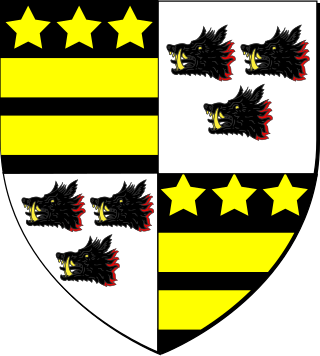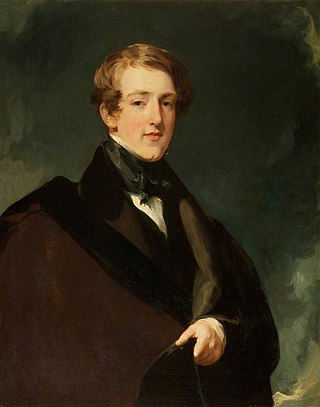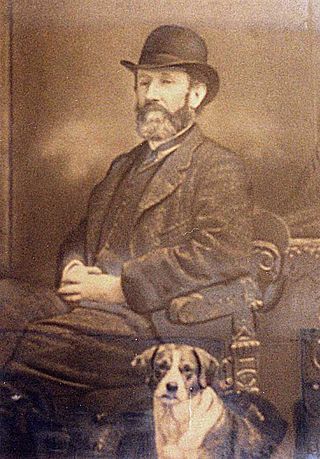
Viscount De L'Isle, of Penshurst in the County of Kent, is a title in the Peerage of the United Kingdom. It was created in 1956 for William Sidney, 6th Baron de L'Isle and Dudley, VC, KG, GCMG, GCVO (1909–1991).

Baron Carbery, of Carbery in the County of Cork, is a title in the Peerage of Ireland. It was created in 1715 for George Evans, with remainder to the heirs male of his father and namesake George Evans, a supporter of William and Mary during the Glorious Revolution, who had earlier declined the offer of a peerage. After his elevation to the peerage, Lord Carbery represented Westbury in the House of Commons. He was succeeded by his eldest son, the second Baron. He also sat as Member of Parliament for Westbury. His grandson, the fourth Baron, briefly represented Rutland in Parliament. He was succeeded by his uncle, the fifth Baron. On his death, the line of the eldest son of the first Baron failed. He was succeeded by his first cousin once removed, the sixth Baron, who had previously succeeded his father as second Baronet, of Castle Freke. Lord Carbery sat in the House of Lords as an Irish Representative Peer from 1824 to 1845. His nephew, the eighth Baron, was an Irish Representative Peer from 1891 to 1894. As of 2014 the titles are held by the latter's great-great-grandson, the twelfth Baron, who succeeded his father in 2012.

Baron Moncreiff, of Tulliebole in the County of Kinross, is a title in the Peerage of the United Kingdom. It was created on 9 January 1874 for the lawyer and Liberal politician Sir James Moncreiff, 1st Baronet. He had already been created a Baronet, of Kilduff in the County of Kinross, in the Baronetage of the United Kingdom on 23 May 1871. In 1883 Lord Moncreiff also succeeded his elder brother as 11th Baronet, of Moncreiff in the County of Perth. On his death the titles passed to his eldest son, the second Baron. He was a Judge of the Court of Session from 1888 to 1905 under the title of Lord Wellwood and served as Lord Lieutenant of Kinross-shire between 1901 and 1909. He was succeeded by his younger brother, the third Baron. He was a clergyman. As of 2010 the titles are held by the latter's great-grandson, the sixth Baron, who succeeded his father in 2002.

Baron Churston, of Churston Ferrers and Lupton in the County of Devon, is a title in the Peerage of the United Kingdom. It was created in 1858 for the former Conservative Member of Parliament, Sir John Yarde, 3rd Baronet. He had earlier represented South Devon in the House of Commons. Two years later, in 1860, he assumed by Royal licence the additional surname of Buller. As of 2023 the titles are held by his great-great-great-great-grandson, the sixth Baron, who succeeded his father in that year.

There have been two baronetcies created for members of the Guinness brewing family, both in the Baronetage of the United Kingdom. As of 2014 both titles are extant.

John Byrne Leicester Warren, 3rd Baron de Tabley was an English poet, numismatist, botanist and an authority on bookplates.

Baron Dufferin and Claneboye, of Ballyleidy and Killyleagh in County Down, Northern Ireland, is a title in the Peerage of Ireland. It was created on 30 July 1800 for Dame Dorcas Blackwood, widow of Sir John Blackwood, 2nd Baronet, Member of the Irish Parliament for Killyleagh and Bangor, in return for support for the Union of Ireland and the United Kingdom.

There have been four baronetcies created for members of the Acland family, which originated in the 12th century at the estate of Acland in the parish of Landkey, North Devon, two in the Baronetage of England and two in the Baronetage of the United Kingdom.

The Anson baronetcy, of Birch Hall in the County Palatine of Lancaster, is a title in the Baronetage of the United Kingdom held by a branch of the Anson family. It was created on 30 September 1831 for William Anson. He was the third son of George Anson; his elder brothers were Thomas Anson, 1st Viscount Anson, and General Sir George Anson. Sir William was the uncle of Thomas Anson, 1st Earl of Lichfield, and Major-General George Anson and the great-nephew of George Anson, 1st Baron Anson. His grandson, the third Baronet, was a lawyer and Liberal Unionist politician. He never married and was succeeded by his nephew, the fourth Baronet. He was the only son of Frederick Arthur Anson, third son of the second Baronet. The fourth baronet drowned in the Thames on an outing of The Coterie in July 1914, after he jumped into the river encouraged by lady Diana Manners. He had not married and on his death the title passed to his first cousin, the fifth Baronet, the eldest son of Rear-Admiral Algernon Horatio Anson (1854–1913), fourth and youngest son of the second Baronet. He was killed in action in the First World War. He was unmarried and was succeeded by his younger brother, the sixth Baronet. His elder son, the seventh baronet, was a Rear-Admiral in the Royal Navy. As of 2021 the title is held by the latter's son, the eighth Baronet, who succeeded in 2018.

There have been twenty one baronetcies created for persons with the surname Williams, eight in the Baronetage of England, three in the Baronetage of Great Britain and ten in the Baronetage of the United Kingdom. Only six of the creations are extant as of 2017.

George Fleming Warren, 2nd Baron de Tabley PC was a British Liberal politician. He notably served as Treasurer of the Household under William Ewart Gladstone between 1868 and 1872.
Sir Edward Stafford Howard, was a British Liberal politician and magistrate.
This is a list of High Sheriffs of Carmarthenshire. Carmarthenshire was originally created by the Statute of Rhuddlan in 1284. It became an administrative county in 1889 with a county council following the Local Government Act 1888. Under the Local Government Act 1972, the administrative county of Carmarthenshire was abolished on 1 April 1974 and the area of Carmarthenshire became three districts within the new county of Dyfed : Carmarthen, Dinefwr and Llanelli. Under the Local Government (Wales) Act 1994, Dyfed was abolished on 1 April 1996 and the three districts united to form a unitary authority which had the same boundaries as the original Carmarthenshire but remaining in the shrievalty of Dyfed.

There have been five baronetcies created for members of the old established family of Peyton of Peyton Hall in the parish of Boxford in Suffolk, all of whom were descended from Sir Robert Peyton of Isleham in Cambridgeshire, grandson and heir of Thomas Peyton (1418–1484) of Isleham, twice Sheriff of Cambridgeshire and Huntingdonshire, in 1443 and 1453. All the baronetcies are extinct.
The 1878 Carmarthen Boroughs by-election was a parliamentary by-election held for the House of Commons constituency of Carmarthen Boroughs in West Wales on 11 May 1878.

The Stepney Baronetcy, of Prendergast in the County of Pembroke, was a title in the Baronetage of England. It was created on 24 November 1621 for John Stepney. His son, Sir John, the third Baronet represented Pembroke and Haverfordwest in Parliament. The latter's nephew, the fourth Baronet, married Justina, daughter of Sir Anthony van Dyck. Their only son, Sir Thomas, the fifth Baronet, sat as Member of Parliament for Carmarthenshire. Sir Thomas's great-grandson, Sir John, the eighth Baronet, represented Monmouth in Parliament and served as Envoy to Dresden and Berlin. The eighth Baronet never married and was succeeded by his younger brother, Sir Thomas, the ninth Baronet, on whose death in 1825 the baronetcy became extinct.

The Stepney family are an English family, who having originated in Stepney, London, made their fortune in lands surrounding Llanelli, West Wales.

Sir Emile Algernon Arthur Keppel Cowell-Stepney, 2nd Baronet was a British landowner and Liberal politician. He was the youngest son of Sir John Stepney Cowell-Stepney (1791–1877).

Sir John Stepney Cowell-Stepney, 1st Baronet, KH (1791–1877) was a British soldier, landowner and politician. He was the elder of the two sons of General Andrew Cowell, originally of Coleshill, Buckinghamshire, and his wife Maria Justina, youngest daughter of Sir Thomas Stepney, 7th baronet of Prendergast, Pembrokeshire, and Llanelly House, Carmarthenshire. He was known as [John] Stepney Cowell until he inherited the Stepney family's estates in 1857 under the terms of the will of his uncle, Sir John Stepney, 8th baronet, when he changed the family's name to Cowell-Stepney.
The 1876 Carmarthen Boroughs by-election was fought on 14 August 1876. The by-election was called following the resignation of the incumbent Conservative MP, Charles William Nevill. It was won by the Liberal candidate Arthur Cowell-Stepney, who was returned unopposed.














